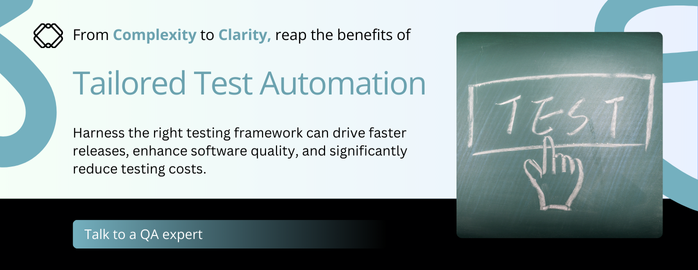Quality assurance has evolved over the years. It now goes beyond detecting and fixing bugs, becoming a formalized set of processes which directly impacts business operations and the quality of service delivery. It has become integral to ensuring a reliable and consistent user experience, tying up with Agile to support faster release cycles.
Even so, many organizations still rely heavily on manual testing, making it a substantial part of the testing process. However, there are certain disadvantages linked with manual testing like limited scalability, human error, and increased time and effort.
Automation testing frameworks help QA teams streamline the testing process. This helps them deliver high-quality software with high efficiency.
An automation testing framework is a set of guidelines, tools, and best practices designed to support testing during the software development process. A good framework proves as a foundation for automating tests, allowing QA teams to test software more consistently and effectively saving time and reducing time-to-market.
Automation frameworks are crucial in testing because they allow reusability and structure automated test cases. Here are some key features of an Automation Testing framework:
We have seen a significant evolution in testing frameworks in the past few years. Here are 7 most important types of testing frameworks:
A linear automation framework is also known as a playback framework suitable for introductory-level testing. In linear testing, quality assurance teams create and run test scripts individually. Linear testing frameworks are fast, simple, and flexible but require high maintenance and are redundant.
In this framework, test cases are broken into smaller modules and then each module is tested independently before testing the whole application. Modular testing frameworks are reusable, scalable, and highly efficient but they are complex and require technical skills to start with.
In this framework, the QA engineer groups similar tasks based on functionality. These grouped items are stored in a library which makes it easy and accessible to reuse the use codes across various test scripts. Library automation frameworks are highly reusable, cost-effective, and scalable but are complex as they require high technical knowledge.
In this framework, test case design is separated from test development. This framework uses a collection of keywords that can be reused within the same test. Each keyword is associated with some action or an object. Keyword-driven testing frameworks are reusable, low maintenance, and scalable but require high development time and high automation knowledge.
The main goal of the data-driven framework is to create reusable test scripts that allow QA testers to test various data sets. This is done by separating test logic data from test scripts and storing them externally. This enables faster testing providing more scalable and flexible testing operation.
With this framework, the QA team, business analysts, and other external stakeholder can participate actively. This is because this framework requires an intermediate level of technical skills, enhancing collaboration but the overall testing process is slow.
This framework combines elements of keyword-driven and data-driven frameworks. This allows users to mitigate weakness making it scalable, reducing cost, and enabling faster testing.
With the right framework, writing, managing, and reusing test data and test cases becomes very easy. This is because an automation testing framework will bring all the necessary automation tools together like test data management, test case management, bug reporting, test labs, etc. in one place. Let’s look at the essential components as it takes various vital elements to make one robust automation testing framework.
For an effective automation framework, utilizing an established test design pattern is important. This helps the framework to ensure the maintainability and reusability of test scripts. A test automation framework may also offer some guidelines for designing compelling test cases.
Test script language is a programming language that a tester will use to write the test scripts. This script will interact with the application under test. Selecting a correct testing script for creating a test script is a very critical decision as the success of the test automation framework depends on the language.
This relates to the core system that executes test scripts, provides feedback, and interacts with the application. The test execution engine also provides suggestions for creating test cases, focusing on modularity, and reusability.
This involves tools and techniques for the generation, overseeing, and management of test data. This ensures accurate, reliable, and comprehensive test execution. Effective test automation frameworks generally have mechanisms for handling test data proficiently, leveraging data-driven methods and tools for generating test data.
Quality Assurance (QA) teams benefit significantly from tools that support continuous integration and deployment, as these tools streamline workflows, boost product quality, shorten release cycles, and maximize return on investment. Choosing a test automation framework that effortlessly aligns with CI/CD platforms like Jenkins, CircleCI, GitLab, or TeamCity is therefore essential to enhancing productivity and collaboration across the team.
Reporting, logging, and debugging refers to the process for creating detailed test execution reports and logs. This component also involves simplifying and streamlining the debug and analysis efforts. The framework should be able to generate comprehensive log records, test reports and error messages.

As we’ve seen in this blog, these testing frameworks bring structure and consistency to accelerate testing processes. From a quality standpoint, they improve the testing precision and hence reliability of the software releases.
As quality assurance continues to evolve along with DevOps and Agile, testing frameworks will remain foundational in maintaining the seamlessness of QA processes. This is exactly why it is important to spend some time in choosing the right framework as per your requirements. The various types of frameworks and their components discussed above will help you zero-in on the perfect fit, creating a strong QA foundation that delivers long-term value.